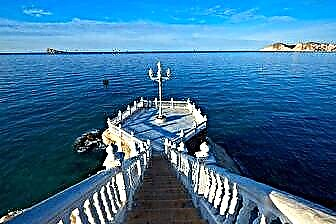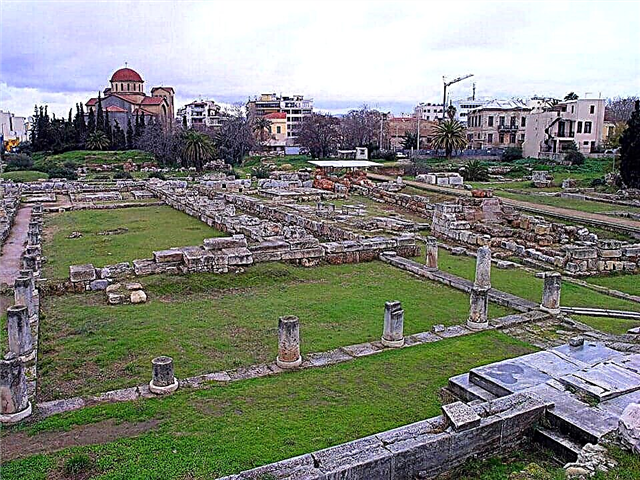While relaxing in a Greek seaside resort, do not miss the opportunity to visit the capital of Greece - Athens, named after the legendary goddess who founded the city according to legend. To touch the ancient history of the Greek capital, 1 day will not be enough even for a quick overview of all the sights. As travelers who managed to be impressed by the history of the city, which experienced its heyday more than 2 thousand years ago, we will advise what to see in Athens in 3 days on your own and how to make your route through significant historical places.
First day
Arriving, it is best to settle in the center near Syntagma Square or nearby Agora in hotels: Thissio View, Phidias Hotel Athens or Art Hotel Athens. From here it is convenient to get around all the sights, since most of them are within walking distance from each other. And so that you do not have to waste time in queues and save money, we advise you to purchase a single ticket to visit 11 major historical sites: the Roman and Athenian Agoras, the Lyceum of Aristotle, the Hadrian's Library, the Museum of Agora and the Archaeological Museum of Ceramics, the Athenian Acropolis, the North and South slopes of the Acropolis, Ceramics, Temple of Olympian Zeus. The validity of such a ticket lasts 5 days. It remains to provide for comfortable walking shoes and hit the road.
Book a private transfer from the airport to your hotel for RUB 2,599
Syntagma Square

We begin our acquaintance with the main square of Greece - Syntagma or Constitution Square, stretching in front of the Palace of Parliament. It is decorated with a large 19th century marble fountain. A luxurious white marble staircase leads from the square to the exquisite classical building of the parliamentary palace. Climbing the steps, you will admire the palace close by and go out to Amalias Avenue to the Monument to the Unknown Soldier, guarded by an honor guard of the Evzon guards, dressed in national costumes.
If you are on a Sunday, crowds of tourists gather here from 10 o'clock in the morning to see an amazing spectacle - a solemn changing of the guard. At 11.00, a company of Evzones in the amount of 150 people march to the monument to the sounds of the orchestra, and the ceremony of changing the guard takes place. Then you can take the Sintagma metro near the square to go to the Station metro stop or walk just over 1 km towards the Acropolis. Not far from the metro exit is the first historical monument included in the Acropolis complex.
Hadrian's Library

The name of Emperor Hadrian, is immortalized by one of the most massive structures of the Acropolis - the library, erected during his reign in 132 AD. The ruler of Greece in this building fulfilled his dream of a secluded place for spiritual development near a bustling bazaar. According to the testimony of contemporaries, the library building with a book depository, lecture and reading rooms was built similarly to the plan of the Acropolis.
A huge rectangle in shape, the scale of which you can imagine today from the remaining western marble wall, was decorated with 100 Corinthian columns, the material for which was the Phrygian stone. The interior was striking with high gilded ceilings, white marble walls with paintings and statues in niches. Having examined the library of Hadrian, we head towards the Roman Agora.
Roman Agora

The Roman Agora, a 3-minute walk from the Library, is not an ordinary shopping area. It was a trade and cultural complex of several buildings. Today you will see the remains of the antique tiles that lined the entire square, antique columns, the building of the Church of Our Lady of Grigorus, the ancient mosque of the Conqueror and the octahedral marble Tower of the Winds. It is also interesting to see the remains of the sewage system and public toilets of Vespasian, designed for 70 places, laid before our era.
The Agora, founded in the 1st century BC, got its name thanks to the donations of the Roman emperor Julius Caesar, as the inscription at the entrance says. Today, the Agora, surrounded by green spaces, is entered through the western entrance, which is conspicuous by four marble columns 8 meters high. When planning your route, keep in mind that the Roman Agora is open for visits from Monday to Friday, inclusive from 8.00 to 15.00.
Tower of winds

The Tower of the Winds is the oldest meteorological structure in the world. The idea to build a tower in the open to all winds of the Roman Agora belongs to the astrologer from Cyrus Andronicus. He also developed the design of the tower - an octagonal white marble structure, towering 13.5 meters, topped with a weather vane indicating the direction of the wind. A sundial was located in the upper part of the tower, showing the time in sunny weather. The main name of the building is "Arida" or the Tower of the Winds, its 8 sides 3.2 meters wide symbolized the 8 divine winds.
The second name of the tower - "Klepsydra" is translated as "Water clock". They were installed inside the tower and powered by water coming from the Acropolis. The building on the south side is distinguished by a round annex, and from the north-east and north-west sides by an entrance with columns of the Corinthian order. The tower is crowned with a canonical ceramic roof. You can watch "Arida" and the restored water clock from 8.00 to 18.30 on any day.
Ancient Agora

The ancient Athenian Agora, located on the Acropolis slope on an area of 5 hectares, is much larger in size than the Roman one. It is better to visit the ancient Agora closer to noon. On its territory is a vast park with trees and shrubs, in the shade of which you can take a break between sightseeing in this open-air museum. Here you will see the ancient Greek ruins of two Bolivions, where the Council meetings were held, the construction of a well-preserved Doric temple of Hephaestus.
Next, go to the Odeon, with columns decorated with 4 athletes. You may be interested in the two-story structure of the portico of the Stoa Attalus and the architecture of the first Athenian-style church of the Holy Apostles of Solaki. If you are interested in ancient Greek history, visit the Archaeological Museum located here, which displays many priceless artifacts found in the Agora during excavations.
Temple of Hephaestus

Walking through the Athenian Agora, be sure to pay attention to the inspection of the well-preserved ancient masterpiece - the Temple of Hephaestus, towering on the Agoraios hill. The first creation of the architects of Attica, built of marble, was dedicated to the god of fire and blacksmithing. The temple was preserved thanks to the efforts of the Greek Orthodox Church of St. George, which occupied the building from the 7th century to the beginning of the 19th century.
All 34 Doric columns miraculously survived and decorative friezes framing the structure, on which you can see sculptures depicting the exploits of Hercules and Theseus, are striking. Upon entering the sanctuary, you will see an open annex leading to the main entrance. In the interior of the annex and the main building of the temple, friezes with relief images of mythological subjects have been preserved. Here there is an indescribable feeling of being in a distant antique era. The temple is open to the public from morning until 18.00.
If you've followed our suggested route, then it's time to have lunch. Just a 2-minute walk away there is a cozy restaurant "All that jatz". Here you can have an inexpensive and tasty meal with fine wine or beer, which the owner of the restaurant treats for free. You will love the great taste of freshly prepared national dishes at an average cost of € 9.
Theater of Dionysus

After a short rest, walk to the Dionysus Theater, located on the eastern slope of the Acropolis.It was built in the 4th century BC on the site of the former temples of the god of winemaking Dionysus. In ancient times, it was a marble structure with 67 rows of seats, designed for 17 thousand spectators. Theatrical performances were performed by Aeschylus and Sophocles. The amphitheater had excellent acoustics. Everything that happened on the stage was perfectly audible in the last rows.
You can see for yourself by standing on the stage and shouting something. The first few rows, made of expensive marble, were intended for the elite. On some seats, you will be able to see the engraved names. During the domination of the Romans, boards with friezes decorated with images of satyrs were installed on the front rows for gladiatorial battles. Today, the Athens Festival is held in the amphitheater from mid-June to mid-September. You can see the amphitheater from 8.30 to 18.00 daily for 12 €.
Acropolis

Climbing from the theater of Dionysus to the top of the hill, we will continue our excursion around the Acropolis - the birthplace of Athens. Translated from Greek, the word Acropolis means a fortress. Built in the 4th century, it served not only as a fortification. Behind its walls was an ancient city, the grandeur and beauty of which you can imagine from the remaining fragments of temples and sanctuaries dedicated to the goddess Athena, and other buildings. We enter the Acropolis through the main gate - Propylaea, going up to the upper platform, we pass the temple of Athena Nike and the temple of the Erechtheion, enchanting with its graceful architecture with columns in the form of statues.
Inside this temple, where several gods were served, you will see the well of Poseidon with salt water, which, according to legend, came from the lord of the seas hitting the rock of the Acropolis with a trident. On the rocky peak, the white marble Parthenon appears in all its grandeur - the temple of the goddess Athena, directed towards the sky with its columns. An unprecedented energy emanates from him, transferring the imagination to the world of the Greek gods. It is best to wander around the ancient ruins of the Acropolis in the late afternoon, when there are fewer tourist groups. It is open from morning until 20.00.
Mount Lycabettus

Do not miss the opportunity to capture in your memory and photo a picturesque picture of an ancient ancient city in the magical light of a sunset from Mount Lycabettus, which is 300 meters high. You can walk to the observation deck or take a funicular.
The funicular runs every 30 minutes. Despite the fact that the observation deck is small, it covers the entire panorama of the city, immersed in the rays of the sunset. There is a cafe on the hill where you can dine and relax while admiring the view of the Acropolis. But, if you do not have time for the sunset on Mount Lycabettus, you will have time to admire its beauty the next day from any hill.
Second day
The second day will be no less intense and interesting. The land of the city and its surroundings is so rich in ancient history that each stone keeps the legends, traditions and myths of Ancient Greece, and the remaining buildings amaze with the skill of ancient architects. We will outline a further route of acquaintance with the sights.
Arch of Hadrian

The next morning, we will go through the national park to see the Hadrian's Arch, enjoying the view of a pond occupied by turtles along the way. The two-tiered marble arch opening before the eyes amazes with its monumentality and grandeur. Built by the Athenians in 131, it stands out for its unique superstructure with three Ionic columns.
The height of the entire structure is 18 meters, width is 13.5 meters, and the walls are 2 meters thick. The construction of the arched gate, named after the emperor Hadrian, was then carried out on the road leading from
The old city to the new city of Adrianopolis created by the monarch. Today the arch overlooks Amalis Avenue, blending harmoniously with the cityscape. It can also be approached from the Constitution Square or from the Acropoli metro station. The road will take no more than 4 minutes. In the evening, the ancient building looks amazing in the backlight.
Temple of Olympian Zeus

Not far from Hadrian's Arch stands the remaining fragment of the Temple of Olympian Zeus of 16 columns topped with Corinthian capitals. Of these, 14 make up the corner and give us an idea of the former scale of the structure. Immediately you will see two towering separately columns and one lying. The consecration of the cult building took place in 132, and the Emperor Hadrian named it in honor of the Olympian god Zeus. The temple served only 300 years, and then was destroyed during the attack of the Heruli.
From historical documents telling about the dimensions of the religious building 17 meters high, 96 meters long and 40 meters wide, it is easy to imagine how grandiose it appeared to contemporaries. Awe of the deity was inspired by his statue, carved from ivory and gold, which is irretrievably lost.
Lyceum of Aristotle

From the Temple of Olympian Zeus, walk to Syntagma Square. Further from the Palace of Parliament in the east direction you will walk to the Lyceum of Aristotle. This historical site, which served as a philosophical gymnasium, was founded by Aristotle in 335 BC. It was a magnificent complex of educational buildings, a gallery and a library. Here the philosopher taught the Athenians oratory and other sciences. Prepared students were engaged in the morning, newcomers were taught science in the afternoon, and in the evening Aristotle lectured for all those wishing to gain knowledge of the townspeople.
Unfortunately, only the foundations of buildings that were excavated not so long ago, when the museum opened in June 2014, remained from the Aristotle Lyceum. This will be the last attraction you see on the Single Ticket. From here, after reaching the Evangelismos metro station, or returning to Syntagma Square, go down to the subway to get to the Tisio stop, from which you can go to the historical cemetery Keramik.
Ceramics

Ceramic is the name of the historic quarter. Its name comes from the potters who lived here in ancient times, making ceramic products. The entire quarter consisted of the urban residential part and the Kerameikos cemetery, separated even before our era by the Themistocles' wall, partially preserved to this day. You will see the Depilonian and Sacred Gates, which served as the entrance to the Kerameikos cemetery. Walking through the ancient churchyard, you can find burials dating back to the Bronze Age and many burials of honorable people.
On the graves, there are gravestone columns installed as monuments, a gravestone relief of two Athenian sisters and a marble bull from the grave of Dionysius in 345 BC. On the territory of the cemetery, you will also see the stele of the envoy from Corfu, the monument to Declissius with a high relief and several family tombs of celebrities. The Keramik Museum exhibits items made by ancient potters and sculptures from the ancient period. Museum expositions can be viewed from early morning until three in the afternoon.
Piraeus

From Keramika, going down the metro, we head to the final stop of the green line to the largest European port - Piraeus. Near the metro there is a harbor where ferries, liners and other sea vessels moor. We advise you to see some interesting sights in the city. A visit to the Archaeological and Maritime Museums will give an opportunity to learn the history of Piraeus through the example of the rarest exhibits. Then, walk to the Baroque Church of Saints Constantine and Helena, built with two bell towers at the beginning of the 18th century.
The church facade with beautiful arched windows, decorative stucco molding and two columns at the entrance amazes with grace. After exploring the church, head to the Dion Archaeological Park, considered a sacred site by the ancient Greeks. At this place, the victories of the Macedonian kings were celebrated, the Olympics were held, and sacrifices were made to the main God - Zeus on the sacrificial altar. From his temple, unfortunately, you will only see the foundation. You can walk in the green park between the fragments of ancient buildings in the summer until 19.00.
The third day
On the third day, it is worth leaving outside the city in a southern direction, where unique natural and historical places are located: the Vulagmeni thermal lake and the southern point of Attica, Cape Sounion. The most convenient way to go there is with an individual excursion for up to 3 tourists. A five-hour excursion conducted by a Russian-speaking guide for 170 € will allow you to learn a lot of interesting things about the sights and feel the enchanting atmosphere of these places.
Lake Vulyagmeni

After driving a little over 20 kilometers, stop at the unique thermal salt lake Vulyagmeni, surrounded by a picturesque mountain. The water temperature from + 22 ° C to + 27 ° C in this natural reservoir is supported by springs gushing from the bottom from a seventeen-meter depth. Due to the content of all kinds of minerals, metals, sulfur and radon, the lake water has a healing effect, and the smell of densely planted eucalyptus and pine trees creates an indescribable atmosphere of the area.
Sandy beaches and warm water beckon for a swim, which you can do by stopping here to experience the miraculous power of the springs. On top of that, unique fish Garra Rufa swim in the warm pond, naturally cleansing the skin of dead cells, rejuvenating it. Not far from Vulyagmeni, archaeologists have found fragments of marble pedestals, colonnades and slabs with the mention of Apollo Zostiros, indicating that people lived here in BC.
Cape Sounion

The continuation of the excursion will be remembered for the scenic road along the shores of the Saronic Gulf. On the way, you will meet several cafes and restaurants famous for their delicious national cuisine. You can stop there for lunch. After driving almost 50 kilometers from Vulyagmeni, you will see an amazing landscape of the southern point of Attica - Cape Sounion. The view of the rocky cliff, washed by the waves of the Aegean Sea, and the ruins of the temple of the sea god Poseidon, towering on the rock, is amazing.
Even the colonnade of 12 grandiose Doric columns, fragments of an architrave depicting Theseus fighting a bull and centaurs fighting the Lapiths, are even impressive. Admiring the stunning sunset over the sea on the ruins of the Poseidon Sanctuary, you will hear from the guide the legends related to the history of its construction, and the story of how luxurious it was in those distant times. You can walk through the ancient ruins of Poseidon until 8 pm, paying 4 € for entrance. After enjoying the magical atmosphere of Cape Sounion, you will return.











